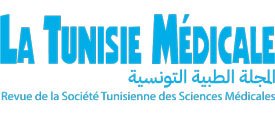FACTEURS DE RISQUES DES PHARYNGOSTOMES
##plugins.themes.academic_pro.article.main##
Résumé
RÉSUMÉ :
Introduction : Le pharyngostome est considéré comme la complication la plus fréquente des laryngectomies et pharyngo-laryngectomies premières et secondaires. Il a un impact important aussi bien sur le patient et son entourage que sur l’équipe soignante. Les facteurs de risque de pharyngostome sont multiples et son traitement n’est pas codifié.
Objectif : Rechercher les différents facteurs pouvant prédisposer à la survenue de cette complication et de décrire les différents moyens thérapeutiques permettant de la juguler.
Méthodes : Notre étude était rétrospective portant sur 68 patients traités pour cancer du larynx par laryngectomie ou pharyngo-laryngectomie totale, au service de chirurgie carcinologique oto-rhino-laryngologique et cervico-faciale de l’institut de Salah Azaїez, durant une période de 3 ans (2015 - 2017).
Résultats : Notre population était majoritairement masculine (97%) et grande consommatrice de tabac et d’alcool. Les stades les plus fréquemment retrouvés étaient le T4aN0M0 (34%) et le T4aN1M0 (22%). Concernant le traitement, 73.5% des patients ont été opérés par laryngectomie totale, 17.7% par pharyngo-laryngectomie totale et 8.8% par laryngectomie carrée. Le pharyngostome a été diagnostiqué dans 20.5% des cas après un délai moyen de 15 jours.
Certains facteurs de risque étaient, après analyse univariée, corrélés statistiquement à la survenue de fistule pharyngo-cutanée (FPC) : l’infiltration pré laryngée (p=0.006), la valeur de la CRP post opératoire (p=0.017), l’extension au sinus piriforme (p=0.009), le stade TNM (p=0.039), la cicatrice sous tension (p=0.000) et un geste thyroïdien associé (p=0.020). Après étude multivariée, six des facteurs de risque objectivés à l’analyse univariée, ont été retrouvés, attestant de leur rôle majeur comme facteur de risque de pharyngostome : l’infiltration pré laryngée (p=0.001), la valeur de la CRP post opératoire (p=0.000), l’atteinte du sinus piriforme (p=0.004), le geste thyroïdien associé et la cicatrice sous tension (p=0.000).
Conclusion : L’identification des facteurs prédictifs de pharyngostome, permet de repérer les patients particulièrement exposés à cette complication, afin d’optimiser la mise en œuvre des moyens nécessaires à sa prévention.
